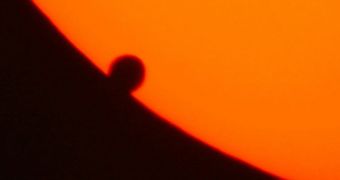One of the rarest events in astronomy will occur next Tuesday and Wednesday, June 5-6. Venus will pass in front of the Sun, an event known as a transit. Telescopes on Earth and in orbit, including the NASA Solar Dynamics Observatory (SDO), will study this phenomenon.
Venus has a peculiar pattern when it comes to solar transits – it carries out two such events at an 8-year interval, and then does not do this again for either 105 or 121 years. The last transit was in June 2004, and the planet will not carry its next set until December 2117 and December 2125, respectively.
This year's event will begin at 22:09 UTC, June 5th and will end at 04:49 UTC, on June 6th. From a scientific standpoint, the beginning and the end of the transit, called ingress and egress, are the most important moments, since they provide the most data.
Historically, Venusian transits provided one of the earliest methods of gaging the distance between Earth and the Sun, as well as the first measurements of Venus. By using the SDO, astronomers hope to gain more data on the neighboring world's atmosphere, and also to calibrate the telescope's instruments.
Experts managing the mission want the instruments to be accurate within a tenth of a pixel. This degree of precision can be achieved by cross-referencing the moments when Venus touches and then leaves the Sun (which are known with extreme precision) with what SDO is seeing.
“Second, the SDO team can use the lightless center of Venus to help calibrate what is called the point spread function of the telescope. This function describes how much light leaks from one pixel into others around it,” NASA experts say.
“Since there is no light emitted from the very center of Venus as it crosses the sun, it serves as a perfect test case for an area of the image where the pixels should remain black,” they go on to say.
In addition, the Venusian atmosphere should become partially transparent to the extreme ultraviolet wavelengths that SDO's instruments are designed to detect. This should theoretically provide new insights into its chemical composition, such as for instance how much oxygen it contains.
Though plagued by a runaway greenhouse effect, the neighboring world is still the closest Earth-analog ever found, especially in terms of mass, density and gravitational pull.

 14 DAY TRIAL //
14 DAY TRIAL //